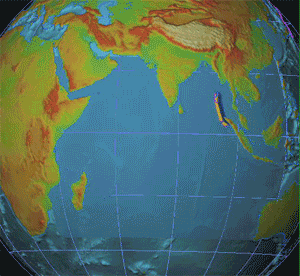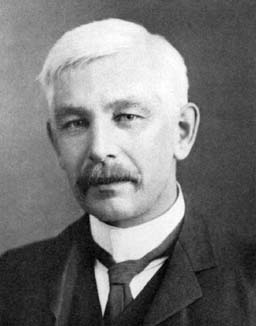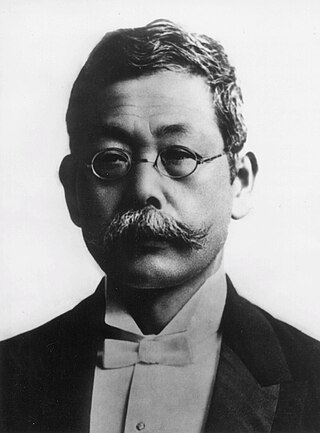Related Research Articles

Seismology is the scientific study of earthquakes and the generation and propagation of elastic waves through the Earth or other planetary bodies. It also includes studies of earthquake environmental effects such as tsunamis as well as diverse seismic sources such as volcanic, tectonic, glacial, fluvial, oceanic microseism, atmospheric, and artificial processes such as explosions and human activities. A related field that uses geology to infer information regarding past earthquakes is paleoseismology. A recording of Earth motion as a function of time, created by a seismograph is called a seismogram. A seismologist is a scientist works in basic or applied seismology.

A seismometer is an instrument that responds to ground displacement and shaking such as caused by quakes, volcanic eruptions, and explosions. They are usually combined with a timing device and a recording device to form a seismograph. The output of such a device—formerly recorded on paper or film, now recorded and processed digitally—is a seismogram. Such data is used to locate and characterize earthquakes, and to study the internal structure of Earth.

The Eskdalemuir Observatory is a UK national environmental observatory located near Eskdalemuir, Dumfries and Galloway, Scotland. Along with Lerwick and Hartland, Eskdalemuir is one of three permanent geomagnetic observatories in the United Kingdom.
Manuel John Johnson, FRS was a British astronomer.

Charles Chree, FRS was a British physicist, an authority on terrestrial magnetism and atmospheric electricity, and for 32 years Superintendent of Kew Observatory.

Edward Francis Pigot was an Irish-born Australian Jesuit priest, seismologist and astronomer. He was president of the New South Wales branch of the British Astronomical Association in 1923–24 and a council member of the Royal Society of New South Wales from 1921 to 1929.

The King's Observatory is a Grade I listed building in Richmond, London. Now a private dwelling, it formerly housed an astronomical and terrestrial magnetic observatory founded by King George III. The architect was Sir William Chambers; his design of the King's Observatory influenced the architecture of two Irish observatories – Armagh Observatory and Dunsink Observatory near Dublin.
Colaba Observatory, also known as the Bombay Observatory, was an astronomical, timekeeping, geomagnetic and meteorological observatory located on the Island of Colaba, Mumbai (Bombay), India.
Robert Stewart Whipple was a businessman in the British scientific instrument trade, a collector of science books and scientific instruments, and an author on their history. He amassed a unique collection of antique scientific instruments that he later donated to found the Whipple Museum of the History of Science in Cambridge in 1944.

A two-mass-skate bicycle (TMS) is a theoretical model created by a team of researchers at Cornell University, University of Wisconsin-Stout, and Delft University of Technology to show that it is neither sufficient nor necessary for a bike to have gyroscopic effects or positive trail to be self-stable. The two-mass and skates aspects of the model were chosen to eliminate design parameters so that the nine that remain, the locations of the masses and the steering geometry, could be more easily analyzed. Instead of full inertia tensors, the total mass of the bike is reduced to just two point masses, one attached to the rear frame and one attached to the front fork. Instead of rotating wheels, the non-holonomic ground contacts are provided by small-radius skates.
Emmanuel Carvallo was a French mathematician. He is notable for showing in 1897 that bicycles could be self-stable, for opposing wave models of X-rays in 1900, and for claiming in 1912 that Einstein's Theory of Relativity had been proven false.

Fusakichi Omori was a pioneer Japanese seismologist, second chairman of seismology at Tokyo Imperial University and president of the Japanese Imperial Earthquake Investigation Committee. Omori is also known for his observation describing the aftershock rate of earthquakes, now known as Omori's law.
An ocean-bottom seismometer (OBS) is a seismometer that is designed to record the earth's motion under oceans and lakes from man-made sources and natural sources.
Harry Oscar Wood (1879–1958) was an American seismologist who made several significant contributions in the field of seismology in the early twentieth-century. Following the 1906 earthquake in San Francisco, California, Wood expanded his background of geology and mineralogy and his career took a change of direction into the field of seismology. In the 1920s he co-developed the torsion seismometer, a device tuned to detect short-period seismic waves that are associated with local earthquakes. In 1931 Wood, along with another seismologist, redeveloped and updated the Mercalli intensity scale, a seismic intensity scale that is still in use as a primary means of rating an earthquake's effects.
John Welsh FRS (1824–1859) was a Scottish meteorologist.

Ethel Frances Butwell Bellamy was an English astronomical computer and seismologist known for her significant contributions to the field of astronomy and seismology. Bellamy collected, measured and updated observations from seismological stations around the world, and served as editor of the International Seismological Summary. In 1928 she was awarded a silver medal by the Pope for her work on understanding the Vatican zone plates.
Elizabeth Martha Beckley was a pioneering British astronomical photographer.
Dr Patrick Lever Willmore FRSE (1921–1994) was a 20th-century British seismologist remembered as inventor of the Willmore seismometer. In authorship he is P. L. Willmore.
Francis "Frank" Napier Denison was a Canadian meteorologist, inventor, seismologist, and astronomer. In the early 20th century he was known to thousands of Victoria's inhabitants as "our weatherman". His most noteworthy invention is perhaps the hydro-aerograph.
Perry Byerly, Jr. was an American geophysicist and seismologist. He was the first professor of seismology at the University of California, Berkeley, and was named emeritus professor in 1965. By 1969, Byerly was considered "one of the foremost seismologists in the country".
References
- ↑ Macdonald, Lee (9 March 2017). "'Work peculiarly fitting to a lady': Elizabeth Beckley and the early years of solar photography". conscicom.org. Archived from the original on 8 May 2019. Retrieved 6 May 2019.
- ↑ C. P. B. Hodgson (1965). The First Eighty Years of Willington School. Willington School, Colinette Road, London SW15. p. 3.
- 1 2 Who Was Who 1941–1950. Bloomsbury Publishing, London. 1980. ISBN 0-7136-2131-1.
- ↑ J. D. G. Kooijman; J. P. Meijaard; J. M. Papadopoulos; A. Ruina; A. L. Schwab (15 April 2011). "A bicycle can be self-stable without gyroscopic or caster effects" (PDF). Science . 332 (6027): 339–342. Bibcode:2011Sci...332..339K. doi:10.1126/science.1201959. PMID 21493856. S2CID 12296078 . Retrieved 16 April 2011.
- ↑ Roger Highfield (June 2007). "The mathematical way to ride a bike". The Telegraph. Archived from the original on 24 November 2010. Retrieved 16 April 2011.
- ↑ J. P. Meijaard; J. M. Papadopoulos; A. Ruina; A. L. Schwab (2007). "Linearized dynamics equations for the balance and steer of a bicycle: a benchmark and review" (PDF). Proceedings of the Royal Society A . 463 (2084): 1955–1982. Bibcode:2007RSPSA.463.1955M. doi:10.1098/rspa.2007.1857. S2CID 18309860.
- ↑ "Whipple, Francis John Welsh (WHPL894FJ)". A Cambridge Alumni Database. University of Cambridge.
- ↑ Pedgley, D. E. (1993). "Pen portraits of Presidents - Francis John Welsh Whipple, MA, SCD, FLNSTP". Weather. 48 (9): 308–309. Bibcode:1993Wthr...48..308P. doi:10.1002/j.1477-8696.1993.tb05917.x.
- ↑ Lovell, J. H.; Henni, P. H. O. (March 1999). Historical Seismological Observatories in the British Isles (Pre-1970), Version 3 (PDF). Technical Report WL/99/13. British Geological Survey, Global Seismology & Geomagnetism Group.
- ↑ "Seismology at Kew Observatory". Nature. 143 (3625): 693. 1 April 1939. Bibcode:1939Natur.143Q.693.. doi: 10.1038/143693a0 . S2CID 4135663.
- ↑ "Report of Seismological Investigations Committee". Nature. 155 (3926): 107. 1 January 1945. Bibcode:1945Natur.155Q.107.. doi:10.1038/155107a0. S2CID 31552396 – via www.nature.com.
- ↑ Pedgley, D. E. (1993). "Pen portraits of Presidents - Francis John Welsh Whipple, MA, SCD, FLNSTP". Weather. 48 (9): 308–309. Bibcode:1993Wthr...48..308P. doi:10.1002/j.1477-8696.1993.tb05917.x.
- ↑ Who Was Who 1951–1960. A & C Black, London. 1984. ISBN 0-7136-2598-8.
- ↑ "Papers of Francis John Welsh Whipple (1876 - 1943)".